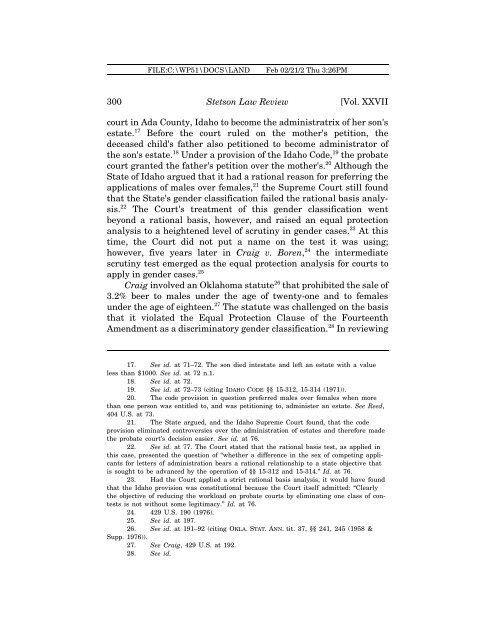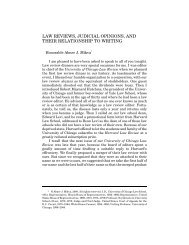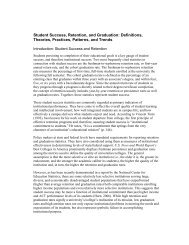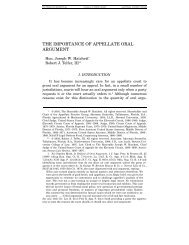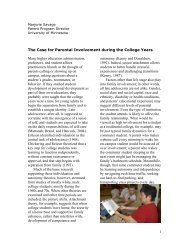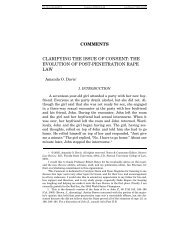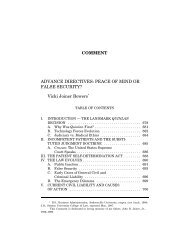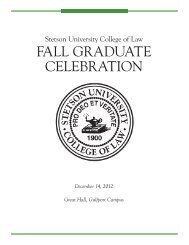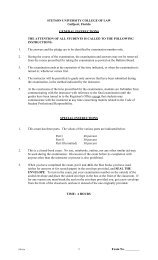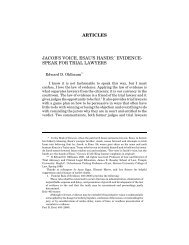The Future of Single-Sex Education After United ... - Stetson University
The Future of Single-Sex Education After United ... - Stetson University
The Future of Single-Sex Education After United ... - Stetson University
You also want an ePaper? Increase the reach of your titles
YUMPU automatically turns print PDFs into web optimized ePapers that Google loves.
FILE:C:\WP51\DOCS\LANDFeb 02/21/2 Thu 3:26PM300 <strong>Stetson</strong> Law Review [Vol. XXVIIcourt in Ada County, Idaho to become the administratrix <strong>of</strong> her son'sestate. 17 Before the court ruled on the mother's petition, thedeceased child's father also petitioned to become administrator <strong>of</strong>the son's estate. 18 Under a provision <strong>of</strong> the Idaho Code, 19 the probatecourt granted the father's petition over the mother's. 20 Although theState <strong>of</strong> Idaho argued that it had a rational reason for preferring theapplications <strong>of</strong> males over females, 21 the Supreme Court still foundthat the State's gender classification failed the rational basis analysis.22 <strong>The</strong> Court's treatment <strong>of</strong> this gender classification wentbeyond a rational basis, however, and raised an equal protectionanalysis to a heightened level <strong>of</strong> scrutiny in gender cases. 23 At thistime, the Court did not put a name on the test it was using;however, five years later in Craig v. Boren, 24 the intermediatescrutiny test emerged as the equal protection analysis for courts toapply in gender cases. 25Craig involved an Oklahoma statute 26 that prohibited the sale <strong>of</strong>3.2% beer to males under the age <strong>of</strong> twenty-one and to femalesunder the age <strong>of</strong> eighteen. 27 <strong>The</strong> statute was challenged on the basisthat it violated the Equal Protection Clause <strong>of</strong> the FourteenthAmendment as a discriminatory gender classification. 28 In reviewing17. See id. at 71–72. <strong>The</strong> son died intestate and left an estate with a valueless than $1000. See id. at 72 n.1.18. See id. at 72.19. See id. at 72–73 (citing IDAHO CODE §§ 15-312, 15-314 (1971)).20. <strong>The</strong> code provision in question preferred males over females when morethan one person was entitled to, and was petitioning to, administer an estate. See Reed,404 U.S. at 73.21. <strong>The</strong> State argued, and the Idaho Supreme Court found, that the codeprovision eliminated controversies over the administration <strong>of</strong> estates and therefore madethe probate court's decision easier. See id. at 76.22. See id. at 77. <strong>The</strong> Court stated that the rational basis test, as applied inthis case, presented the question <strong>of</strong> “whether a difference in the sex <strong>of</strong> competing applicantsfor letters <strong>of</strong> administration bears a rational relationship to a state objective thatis sought to be advanced by the operation <strong>of</strong> §§ 15-312 and 15-314.” Id. at 76.23. Had the Court applied a strict rational basis analysis, it would have foundthat the Idaho provision was constitutional because the Court itself admitted: “Clearlythe objective <strong>of</strong> reducing the workload on probate courts by eliminating one class <strong>of</strong> contestsis not without some legitimacy.” Id. at 76.24. 429 U.S. 190 (1976).25. See id. at 197.26. See id. at 191–92 (citing OKLA. STAT. ANN. tit. 37, §§ 241, 245 (1958 &Supp. 1976)).27. See Craig, 429 U.S. at 192.28. See id.


